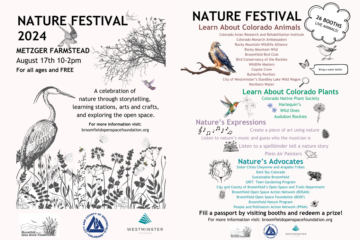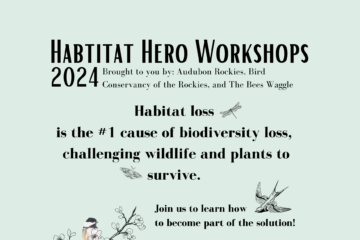Bird City!
The City and County of Broomfield is now officially designated as a Bird City, the third city in the state to do so. Other Colorado Bird Cities include Lafayette and Fort Collins.
The application to become a Bird City is rigorous and includes action items such as habitat improvements, hosting a world migratory day event, community education and engagement, addressing current threats to birds, and making steps toward sustainability, just to list a few. This is where community members can step in to support our new Bird City status!
What are birds?
Birds are Avian species and they are descendants of dinosaurs who sing beautiful songs and dress in gorgeous feathers, no kidding. Luckily, for us, they are tiny dinosaurs. There are many groups of birds carrying out important functions in their ecosystems.
Birds can be carnivores, omnivores, insectivores, and nectarivores. Physical traits of each group support the birds’ function. Carnivorous raptors have sharp talons and sharp beaks to capture prey, and tear and eat meat. Omnivorous birds host bulky, shell crushing beaks, feeding on insects, seeds, and berries. Insectivorous birds host petite beaks built to catch and eat tiny insects. Nectarivores, such as hummingbirds (truly omnivores that feed on nectar instead of seeds and fruits), feed on nectar in flowers, and in doing so pollinate the flowers they visit, they also feed on insects, and their beaks reflect those functions.
Feathers keep birds warm and dry, and their structures mirror the function of the bird they cover. Birds of prey have feathers that keep quiet as the bird flies for successful hunts. On the other hand, omnivore, insectivore, and nectarivore bird feathers are audible as the birds fly. The colors of feathers can blend into surroundings assisting with camouflage, and on the other can can also be bright and showy for attracting a mate. The wide spectrum of feather color and pattern combinations across all bird species is astonishing.
Some birds make long journeys, migrating to warmer climates in the winter, seeking food sources, or toward annual mating grounds in the spring. Other birds stay in the same place year round making use of existing resources.
Birds have their own songs used to communicate with each other as well as other animals, including us. We love bird songs so much that we have music playlists that include bird song recordings for relaxation and sleep.
The world of birds is fascinating, captivating, and easily becomes a rabbit hole for many people. Birds are very capable of survival, but not without our help, as there are many challenges birds are facing at present, with habitat loss being the most important.
Become a bird expert!
Study with The Cornell Lab of Ornithology
Join the Broomfield Bird Club
How can you help?
With habitat loss being the most important challenge birds are facing today, we can support them by putting habitat back where it’s been lost, and restoring or uplifting existing habitats in our community.
1. Providing bird feeders and bird baths offers important resources for birds, and can become a project for you. Project Feeder Watch through The Cornell Universisy’s Lab of Ornithology runs an annual citizen science project tracking birds at feeders at feeders across North America. Participating in this project helps scientists and builds your bird literacy.
2. Planting a native garden that includes native trees, shrubs, flowering plants, and native grasses provides a complete portfolio of support for all birds in our community. If it isn’t feasible to achieve all levels of support, any plot of native plants you can offer will provide important resources for birds. See below for lists of native plants and places to find native plants.
3. Supporting our local open spaces by participating in the Broomfield Open Space Action Network (BOSAN) events will also support our Avian neighbors. Bio blitzes, invasive weed removal, and plantings all serve to support the well-being of our local bird populations. Not everyone has a yard to plant native gardens in so this is a nice alternative activity to become a key feather supporting community member. BOSAN events will be posted on the Broomfield Open Space Foundation website in the coming weeks, keep your eyes peeled!
4. Encouraging others to join in the bird loving actions! We can be powerful when we share our ideas with others and sometimes that’s all someone needs to take action. Spreading the word about ways to support birds is a very valuable action to take.
Birds bring joy and excitement to our open spaces and yards. We love to see large raptors perched in surprising places along our daily walks, we strive to invite songbirds and hummingbirds into our yards by placing feeders, bird baths, and planting bird friendly native gardens. Spreading the love for birds in Broomfield will make this the most tweet worthy Bird City yet!
We are part of nature and any contributions aimed at elevating our local ecosystems is felt by our feathery friends.
More ways to help birds
Bird Conservancy of the Rockies
The Cornell Lab of Ornithology
Plant lists and programs for native gardening
Audubon Rockies Habitat Hero Program
Get native plants



